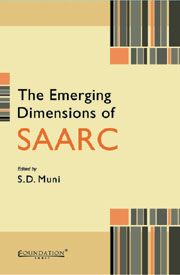Book contents
- Frontmatter
- Contents
- Preface
- List of Figures
- List of Tables
- 1 SAARC Prospects: The Changing Dimensions
- 2 SAARC and South Asian Economic Integration
- 3 Coping with the Emerging Challenges: Poverty and Food Security
- 4 SAARC Energy Cooperation: Energy Security and Environmental Challenges
- 5 Sub-Regional Cooperation under SAARC: An Economic Analysis
- 6 SAARC: Social Charter and Human Security
- 7 SAARC and the South Asian Security Architect
- 8 Fighting Terrorism through SAARC?
- 9 SAARC and the Evolving Asian Regionalism
- 10 Role of SAARC Observers: Members' Perspectives
- 11 Role of SAARC Observers: Observers' Perspectives
- 12 Concluding Remarks
- About the Contributors
- Index
5 - Sub-Regional Cooperation under SAARC: An Economic Analysis
Published online by Cambridge University Press: 26 October 2011
- Frontmatter
- Contents
- Preface
- List of Figures
- List of Tables
- 1 SAARC Prospects: The Changing Dimensions
- 2 SAARC and South Asian Economic Integration
- 3 Coping with the Emerging Challenges: Poverty and Food Security
- 4 SAARC Energy Cooperation: Energy Security and Environmental Challenges
- 5 Sub-Regional Cooperation under SAARC: An Economic Analysis
- 6 SAARC: Social Charter and Human Security
- 7 SAARC and the South Asian Security Architect
- 8 Fighting Terrorism through SAARC?
- 9 SAARC and the Evolving Asian Regionalism
- 10 Role of SAARC Observers: Members' Perspectives
- 11 Role of SAARC Observers: Observers' Perspectives
- 12 Concluding Remarks
- About the Contributors
- Index
Summary
Efforts to promote sub-regional economic cooperation within the SAARC are almost a decade old. These took shape in the 9th SAARC Summit at Male in 1997. The Summit endorsed the promotion of a South Asia Growth Quadrangle (SAGQ) within the SAARC framework. The SAGQ comprises the four South Asian countries of Bangladesh, Bhutan, India and Nepal (BBIN). The BBIN growth quadrangle was expected to create a facilitating environment for growth and development through identification and implementation of specific projects.
The SAGQ was conceived to be developed through the active institutional support and technical assistance of the Asian Development Bank (ADB). This led to the launching of the South Asia Sub-Regional Economic Cooperation (SASEC) Programme in September 2000. The SASEC emphasises on project-based development in the SAGQ. There are six priority sectors. These include – transport, energy and power, tourism, environment, trade, investment, and private sector cooperation, and information and communications technology.
Till now, SAGQ is the only sub-regional initiative exclusive to the SAARC framework. South Asia has experienced the growth of other sub-regional initiatives like the BIMSTEC. However, BIMSTEC is a ‘SAARC plus’ arrangement as it includes members from East Asia as well. In that sense, the SAGQ is conceptually identical to similar initiatives in Southeast Asia that include the Indonesia–Malaysia–Singapore Growth Triangle (IMS-GT) or the Brunei–Indonesia–Malaysia–Philippines (BIMP) sub-grouping.
- Type
- Chapter
- Information
- The Emerging Dimensions of SAARC , pp. 113 - 131Publisher: Foundation BooksPrint publication year: 2010
- 1
- Cited by

